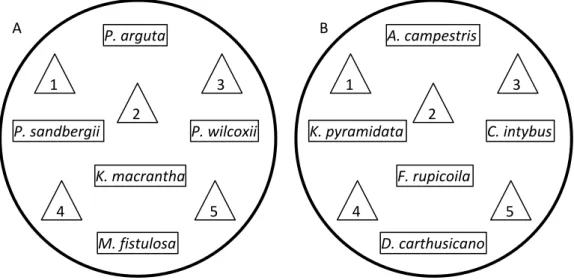Invasions by alien plants threaten the integrity of agricultural and natural systems, causing enormous economic and ecological cost. Throughout western North America, plant invasions have resulted in the replacement of vast areas of native perennial grasses with Eurasian and Mediterranean plants. Various factors have been shown to contribute to the negative impact of invasive alien plants, but their relative importance remains unclear. We assessed the relative effects of neighbouring plant community and soil biota in
explaining the negative impact of spotted knapweed, Centaurea stoebe L., during the invasion of new sites in North America.
We conducted a greenhouse
experiment with both European and North American spotted knapweed competing with/without European vs. North American neighbouring
community and with the two
neighbouring communities growing without knapweed. Plants were grown in sterilized commercial soil inoculated with soil originating either from the home or the introduced range, and half of which was sterilized to remove soil biota. Our results suggest that during the colonization of new sites in North American grasslands, the impact of spotted knapweed is strongly driven by the lower competitive ability of
new (North American) neighbours compared with old (European) neighbours, while altered biotic soil conditions in the introduced range are of less importance. Interestingly, this differential impact appears to be due to inherently different
mechanisms, as biomass of knapweed explained a substantial amount of the variation in biomass of the coevolved European neighbours, but not of the new "naïve" North American neighbours. Thus, impact in the home range appears to be driven by simple competition for the same limiting resources, but by other factors in the introduced range, possibly by exploitation of resources that are not used by the new
neighbours or by a direct chemical impact on those neighbours (e.g. allelopathy effects). These findings, if applicable to other species, have important implications for the
management of alien invasive plants, in that ecosystem recovery is less likely after a simple removal of their biomass.
Why do some plant species become so successful and
wide-spread away from home?
Yan Sun, Heinz Müller-Schärer and Urs Schaffner
Spotted knapweed in USDA Field Station in Missoula, USA (left) and a knapweed individual (right). Courtesy of Norman E. Rees & Ivan Bliek.
Supplementary:
Fig. S1. Graphical layout of the study concept: soil origin, i.e. soils in the introduced range and home range, native community origin and genotypes of the invader all might contribute to the impact of invader at new sites in the introduced range. Thus we set up a full-factorial experiment to assess the relative importance of these three factors, i.e. soils, native communities and invader from both the introduced and home range.
New sites Colonization of new sites
Colonization of new sites
Introduced range
Home range
Soil in the home range Soil in the introduced range
Fig. S2. Graphical layout of our full-factorial experimental design of three factors: ‘naïve’ soils, native communities and invader from both the introduced and home range.
‘naïve’ soil
Colonization of new sites Colonization of new sites
Introduced range
Home range
Fig. S3. The arrangement of five North American (A) and European (B) native neighbour
plants and five C. stoebe in the interspecies competition pot, triangles are C. stoebe. We used this 1:1 competition ratio (i) to maximise interaction between C. stoebe and its neighbours, and (ii) to have the same number of the target (C. stoebe) and the response plants (the neighbouring community) assuming differences between them. The same ratio has also been used by other authors for their greenhouse competition experiments with C. stoebe (Callaway, DeLuca & Belliveau 1999; Marler, Zabinski & Callaway 1999).
References
Callaway, R.M., DeLuca, T.H. & Belliveau, W.M. (1999) Biological-control herbivores may increase competitive ability of the noxious weed Centaurea maculosa. Ecology, 80, 1196-1201.
Marler, M.J., Zabinski, C.A. & Callaway, R.M. (1999) Mycorrhizae indirectly enhance
competitive effects of an invasive forb on a native bunchgrass. Ecology, 80, 1180-1186.
P. arguta P. sandbergii P. wilcoxii K. macrantha M. fistulosa 1 2 3 4 5 A. campestris K. pyramidata C. intybus F. rupicoila D. carthusicano 1 2 3 4 5 A B
Supplementary:
Table S1. Origin of Centaurea stoebe populations.
Site code Longitude Latitude
Germany (Europe) DE3 11°08'56.49" E 49°41'68.40" N DE4 10°63'14.38" E 49°99'36.74" N DE5 10°65'75.61" E 50°29'83.27" N Montana (North America) U.S.MT3 113°97'49.00" W 45°83'46.47" N U.S.MT5 111°39'43.88" W 44°85'53.10" N U.S.MT6 110°83'19.50" W 45°29'59.71" N U.S.MT9 112°12'56.61" W 47°30'05.66" N
Table S2. Soil collection sites.
Area Longitude Latitude
Switzerland (Europe) Zetzwil 8°15'28.68" E 47°28'23.59" N Gortenschwil 8°14'25.04" E 47°28'07.87" N Bière 6°34'44.53" E 46°52'56.75" N Montana (North America) Grant creek 114°01'06.6" W 46°56'07.7" N Jumbo 113°58'22.89"W 46°52'14.08"N Kleinschmidt 113°4'58.95"W 46°57'55.87"N
Table S3. Statistical results of Figures 1, 2 & 3 (chi-square value of zero indicates no
significant treatment effect).
Fig. 1.
biomass of neighbouring
community reduction in biomass
chi-square P-value chi-square P-value
un-sterilized soil neighbour origin 18.46 <0.001 21.35 <0.001 soil origin 2.23 0.14 2.18 0.14 Neighbour × soil 1.29 0.26 2.78 0.10 sterilized soil neighbour origin 38.23 <0.001 38.49 0.01 soil origin 0.36 0.55 3.74 0.05 Neighbour × soil 0.37 0.54 0.49 0.48 Sterilization 62.74 <0.001 25.37 <0.001
Fig. 2. biomass of C. stoebe reduction in biomass
chi-square P-value chi-square P-value
un-sterilized soil neighbour origin 6.44 0.01 4.44 0.03 soil origin 4.86 0.03 0.01 0.92 Neighbour × soil 0.04 0.84 0.06 0.81 sterilized soil neighbour origin 18.36 <0.001 6.37 0.01 soil origin 2.63 0.11 0.86 0.35 Neighbour × soil 0.73 0.39 0.52 0.47 Sterilization 17.14 <0.001 1.99 0.16 Fig. 3. REI chi-square P-value un-sterilized soil neighbour origin 53.52 <0.001 soil origin 0 ns. Neighbour × soil 0.06 0.81 sterilized soil neighbour origin 41.43 <0.001 soil origin 0 ns. Neighbour × soil 0.67 0.41 Sterilization 0.008 0.93





